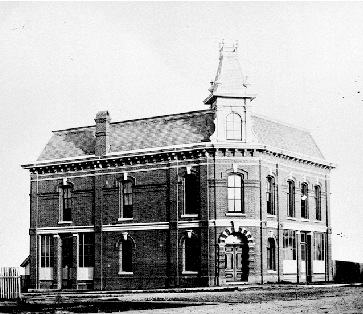The Masonic Temple
"Unless our order were good and our calling honorable we should not have existed for so many centuries, nor should we have been honored with the patronage of so many illustrious men in ages…" - Most Worshipful Grand Master, Eli Harrison, Senior, April 23, 1878 at the cornerstone ceremony for Victoria's Masonic Temple

The Victoria Masonic Temple circa 1880. The architectural plans were drawn up by Victoria resident and Freemason John Teague. Teague was responsible for the design of many Victoria landmarks, including: Victoria City Hall, Church of our Lord, and the 1886 addition to St. Ann's Convent School.
The evolution of the Masonic fraternity in Victoria paralleled the rapid growth and industrialization of the city. With an influx of migrants arriving in Victoria in 1858 en route to the Fraser River gold rush, the cultural and environmental landscape of the coastal community underwent significant transformation. The fraternity of Free and Accepted Masons was one of the first organizations to assemble in the city at that time. With historic roots in Masonic craftsmanship, the organization facilitated professional advancement and business success for many of the men who colonized the Pacific Coast of British Columbia.
Reflecting on the introduction of Freemasonry into British Columbia, Brother DeWolf Smith noted the following in 1909: “The first gathering of Freemasons in British Columbia of which we have any record was held on the 6th of September, 1859 [in Victoria.] It was an informal meeting, held for the purpose of arranging for the funeral of Brother Samuel J. Hazeltine.” Thus, by the fall of 1859, the fraternity had enough cohesion and organization to ensure that deceased Masonic members received proper burial honours. The creative resilience of Victoria's earliest Masons is evidenced in the makeshift clothes that were pulled together for Bro. Hazeltine's funeral: a tent maker on Yates street was commissioned to piece together Masonic aprons for the occasion!
Through the 1860s and 1870s, members of Victoria's Masonic Lodges were called on to lay many of the city's cornerstones with proper Masonic honours. Although the Masonic fraternity conducted business behind closed doors, the cornerstone ceremonies were public events that mediated the interaction of the broader community with some of Victoria's most eminent citizens. That these eminent citizens were also Masons was no coincidence. The prestige of membership in a fraternal organization like the Masonic Order was important in constructing and maintaining a proud, professional identity.
The symbolic importance of the cornerstone could not be underestimated in Victorian times; because it was the main point from which to start the building, it had to be laid correctly for all that followed to be correct. This strong sense of propriety and duty shaped the formal language of Masonic speech. During the laying of the cornerstone for the Mortuary Chapel of the Masonic Cemetery at Sapperton in 1872, Most Worshipful Grand Master Israel Wood Powell noted, “We admit into our Order only such as are reported to be good men and true, of a lawful age, good morals and sound judgment. We meet upon the level, and are constantly instructed to square our conduct by the principles of morality and virtue.”
These principles, quoted above, are an important part of any interpretation that we make as we review the history of Victoria's cornerstones and time capsules. The laying of the cornerstone for the Masonic Temple on the corner of Douglas and Fitzgard streets was a significant occasion for Victoria's Masonic members. The procession of Masonic officers and visiting Brethren was most imposing, with members carrying banners, architectural plans, ceremonial offerings, Masonic regalia, Craft tools, a volume of Sacred Law, and other objects and texts of special utility and significance.

Click here to learn more about Eli Harrison Sr.
View References for this Page






